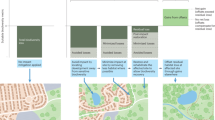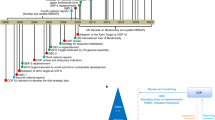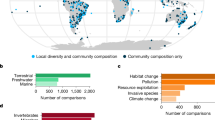Abstract
Human activities are degrading ecosystems worldwide, posing existential threats for biodiversity and humankind. Slowing and reversing this degradation will require profound and widespread changes to human behaviour. Behavioural scientists are therefore well placed to contribute intellectual leadership in this area. This Perspective aims to stimulate a marked increase in the amount and breadth of behavioural research addressing this challenge. First, we describe the importance of the biodiversity crisis for human and non-human prosperity and the central role of human behaviour in reversing this decline. Next, we discuss key gaps in our understanding of how to achieve behaviour change for biodiversity conservation and suggest how to identify key behaviour changes and actors capable of improving biodiversity outcomes. Finally, we outline the core components for building a robust evidence base and suggest priority research questions for behavioural scientists to explore in opening a new frontier of behavioural science for the benefit of nature and human wellbeing.
This is a preview of subscription content, access via your institution
Access options
Access Nature and 54 other Nature Portfolio journals
Get Nature+, our best-value online-access subscription
$32.99 / 30 days
cancel any time
Subscribe to this journal
Receive 12 digital issues and online access to articles
$119.00 per year
only $9.92 per issue
Buy this article
- Purchase on SpringerLink
- Instant access to full article PDF
Prices may be subject to local taxes which are calculated during checkout


Similar content being viewed by others
References
Summary for Policymakers of the Global Assessment Report on Biodiversity and Ecosystem Services of the Intergovernmental Science-Policy Platform on Biodiversity and Ecosystem Services http://rid.unrn.edu.ar/handle/20.500.12049/4223 (IPBES Secretariat, 2019).
Maxwell, S. L., Fuller, R. A., Brooks, T. M. & Watson, J. E. M. Biodiversity: The ravages of guns, nets and bulldozers. Nature 536, 143–145 (2016).
Living Planet Report 2020—Bending the Curve of Biodiversity Loss (WWF, 2020).
Ceballos, G. et al. Accelerated modern human-induced species losses: entering the sixth mass extinction. Sci. Adv. 1, e1400253 (2015).
Ceballos, G., Ehrlich, P. R. & Dirzo, R. Biological annihilation via the ongoing sixth mass extinction signaled by vertebrate population losses and declines. Proc. Natl Acad. Sci. USA 114, E6089–E6096 (2017).
Tilman, D. et al. Future threats to biodiversity and pathways to their prevention. Nature 546, 73–81 (2017).
Partridge, E. Nature as a moral resource. Environ. Ethics 6, 101–130 (1984).
Ehrenfeld, D. in Biodiversity (ed. Wilson, E. O.) 212–216 (National Academy Press, 1988).
Taylor, P. W. The ethics of respect for nature. Environ. Ethics 3, 197–218 (1981).
Clayton, S. in The Virtues of Sustainability (ed. Kawall, J.) Ch. 1 (Oxford Univ. Press, 2021).
Feinberg, M. & Willer, R. The moral roots of environmental attitudes. Psychol. Sci. 24, 56–62 (2013).
Kellert, S. R. The Value of Life: Biological Diversity and Human Society (Island Press, 1997).
Bratman, G. N. et al. Nature and mental health: an ecosystem service perspective. Sci. Adv. 5, eaax0903 (2019).
Díaz, S. et al. Assessing nature’s contributions to people. Science 359, 270–272 (2018).
Gibb, R. et al. Zoonotic host diversity increases in human-dominated ecosystems. Nature 584, 398–402 (2020).
Balmford, A., Fisher, B., Mace, G. M., Wilcove, D. S. & Balmford, B. COVID-19: Analogues and lessons for tackling the extinction and climate crises. Curr. Biol. 30, R969–R971 (2020).
Dobson, A. P. et al. Ecology and economics for pandemic prevention. Science 369, 379–381 (2020).
Allen, T. et al. Global hotspots and correlates of emerging zoonotic diseases. Nat. Commun. 8, 1124 (2017).
Morens, D. M., Daszak, P., Markel, H. & Taubenberger, J. K. Pandemic COVID-19 joins history’s pandemic legion. mBio 11, e00812-20 (2020).
Wilkinson, D. A., Marshall, J. C., French, N. P., Hayman, D. T. S. & Wilkinson, D. A. Habitat fragmentation, biodiversity loss and the risk of novel infectious disease emergence. J. R. Soc. Interface 15, 20180403 (2018).
Mallapaty, S. Where did COVID come from? WHO investigation begins but faces challenges. Nature 587, 341–342 (2020).
Tilman, D. & Clark, M. Global diets link environmental sustainability and human health. Nature 515, 518–522 (2014).
Poore, J. & Nemecek, T. Reducing food’s environmental impacts through producers and consumers. Science 992, 987–992 (2018).
‘t Sas-Rolfes, M., Challender, D. W. S., Hinsley, A., Veríssimo, D. & Milner-Gulland, E. J. Illegal wildlife trade: scale, processes, and governance. Annu. Rev. Environ. Resour. 44, 201–230 (2019).
Dietz, T. Drivers of human stress on the environment in the twenty-first century. Annu. Rev. Environ. Resour. 42, 189–213 (2017).
Balmford, A. et al. Capturing the many dimensions of threat: comment on Salafsky et al. Conserv. Biol. 23, 482–487 (2009).
Nepstad, D. C., Stickler, C. M. & Almeida, O. T. Globalization of the Amazon soy and beef industries: opportunities for conservation. Conserv. Biol. 20, 1595–1603 (2006).
zu Ermgassen, E. K. H. J. et al. Results from on-the-ground efforts to promote sustainable cattle ranching in the Brazilian Amazon. Sustainability 10, 1301 (2018).
MacFarlane, D. et al. Reducing demand for overexploited wildlife products: Lessons from systematic reviews from outside conservation science. Preprint at OSF https://osf.io/preprints/8935b/ (2020).
Thomas-Walters, L. et al. Motivations for the use and consumption of wildlife products. Conserv. Biol. 35, 483–491 (2021).
Johnson, C. K. et al. Global shifts in mammalian population trends reveal key predictors of virus spillover risk. Proc. R. Soc. B 287, 20192736 (2020).
Avery, M. Inglorious: Conflict in the Uplands (Bloomsbury, 2015).
Cowling, R. M. Let’s get serious about human behavior and conservation. Conserv. Lett. 7, 147–148 (2014).
Marselle, M., Turbe, A., Shwartz, A., Bonn, A. & Colléony, A. Addressing behavior in pollinator conservation policies to combat the implementation gap. Conserv. Biol. 35, 610–622 (2021).
Saunders, C. D. The emerging field of conservation psychology. Hum. Ecol. Rev. 10, 137–149 (2003).
Selinske, M. J. et al. Revisiting the promise of conservation psychology. Conserv. Biol. 32, 1464–1468 (2018).
Schultz, P. W. Conservation means behavior. Conserv. Biol. 25, 1080–1083 (2011).
Cinner, J. How behavioral science can help conservation. Science 362, 889–891 (2018).
Reddy, S. M. W. et al. Advancing conservation by understanding and influencing human behavior. Conserv. Lett. 10, 248–256 (2017).
Burgess, G. Powers of persuasion? Conservation communications, behavioural change and reducing demand for illegal wildlife products. TRAFFIC Bull. 28, 65–73 (2016).
Kidd, L. R. et al. Messaging matters: A systematic review of the conservation messaging literature. Biol. Conserv. 236, 92–99 (2019).
Ostrom, E. et al. The Drama of the Commons (National Academy Press, 2002).
Dietz, T., Ostrom, E. & Stern, P. C. The struggle to govern the commons. Science 302, 1907–1912 (2003).
Ostrom, E. Governing the Commons: The evolution of Institutions for Collective Action (Cambridge Univ. Press, 1990).
Stern, P. C., Young, O. R. & Druckman, D. E. Global Environmental Change: Understanding the Human Dimensions (National Academy Press, 1992).
Veríssimo, D. The past, present, and future of using social marketing to conserve biodiversity. Soc. Mar. Q. 25, 3–8 (2019).
Veríssimo, D. et al. Does it work for biodiversity? Experiences and challenges in the evaluation of social marketing campaigns. Soc. Mar. Q. 24, 18–34 (2018).
Green, K. M., Crawford, B. A., Williamson, K. A. & DeWan, A. A. A meta-analysis of social marketing campaigns to improve global conservation outcomes. Soc. Mar. Q. 25, 69–87 (2019).
DeWan, A., Green, K., Li, X. & Hayden, D. Using social marketing tools to increase fuel-efficient stove adoption for conservation of the golden snub-nosed monkey, Gansu Province, China. Conserv. Evid. 10, 32–36 (2013).
McDonald, G. et al. Catalyzing sustainable fisheries management though behavior change interventions. Conserv. Biol. 35, 1176–1189 (2020).
Veríssimo, D. & Wan, A. K. Y. Characterizing efforts to reduce consumer demand for wildlife products. Conserv. Biol. 33, 623–633 (2019).
Byerly, H. et al. Nudging pro-environmental behavior: evidence and opportunities. Front. Ecol. Environ. 16, 159–168 (2018).
van der Linden, S., Maibach, E. & Leiserowitz, A. Improving public engagement with climate change: five ‘best practice’ insights from psychological science. Perspect. Psychol. Sci. 10, 758–763 (2015).
Chapman, D. A., Lickel, B. & Markowitz, E. M. Reassessing emotion in climate change communication. Nat. Clim. Chang. 7, 850–852 (2017).
Nisa, C. F., Bélanger, J. J., Schumpe, B. M. & Faller, D. G. Meta-analysis of randomised controlled trials testing behavioural interventions to promote household action on climate change. Nat. Commun. 10, 4545 (2019).
Valkengoed, A. M. Van & Steg, L. Meta-analyses of factors motivating climate change adaptation behaviour. Nat. Clim. Chang. 9, 158–163 (2019).
Nielsen, K. S. et al. How psychology can help limit climate change. Am. Psychol. 76, 130–144 (2021).
Dessart, F. J., Barreiro-Hurlé, J. & van Bavel, R. Behavioural factors affecting the adoption of sustainable farming practices: a policy-oriented review. Eur. Rev. Agric. Econ. 46, 417–471 (2019).
Palm-Forster, L. H., Ferraro, P. J., Janusch, N., Vossler, C. A. & Messer, K. D. Behavioral and experimental agri-environmental research: methodological challenges, literature gaps, and recommendations. Environ. Resour. Econ. 73, 719–742 (2019).
Wallen, K. E. & Kyle, G. T. The efficacy of message frames on recreational boaters’ aquatic invasive species mitigation behavioral intentions. Hum. Dimens. Wildl. 23, 297–312 (2018).
Metcalf, A. L., Angle, J. W., Phelan, C. N., Muth, B. A. & Finley, J. C. More ‘bank’ for the buck: microtargeting and normative appeals to increase social marketing efficiency. Soc. Mar. Q. 25, 26–39 (2019).
Green, K. M., DeWan, A., Arias, A. B. & Hayden, D. Driving adoption of payments for ecosystem services through social marketing, Veracruz, Mexico. Conserv. Evid. 10, 48–52 (2013).
Stern, P. C. & Dietz, T. A broader social science research agenda on sustainability: Nongovernmental influences on climate footprints. Energy Res. Soc. Sci. 60, 101401 (2020).
Niemiec, R. M., Sekar, S., Gonzalez, M. & Mertens, A. The influence of message framing on public beliefs and behaviors related to species reintroduction. Biol. Conserv. 248, 108522 (2020).
Watts, D. J. Should social science be more solution-oriented?. Nat. Hum. Behav. 1, 0015 (2017).
Berkman, E. T. & Wilson, S. M. So useful as a good theory? The practicality crisis in (social) psychological theory. Perspect. Psychol. Sci. https://doi.org/10.1177/1745691620969650 (2021).
Giner-Sorolla, R. From crisis of evidence to a ‘crisis’ of relevance? Incentive-based answers for social psychology’s perennial relevance worries. Eur. Rev. Soc. Psychol. 30, 1–38 (2019).
Henrich, J., Heine, S. J. & Norenzayan, A. The weirdest people in the world? Behav. Brain Sci. 33, 61–83 (2010).
Rad, M. S., Martingano, A. J. & Ginges, J. Toward a psychology of Homo sapiens: making psychological science more representative of the human population. Proc. Natl Acad. Sci. USA 115, 11401–11405 (2018).
Ewert, B. Moving beyond the obsession with nudging individual behaviour: towards a broader understanding of behavioural public policy. Public Policy Adm. 35, 337–360 (2020).
Bhargava, B. S. & Loewenstein, G. Behavioral economics and public policy 102: beyond nudging. Am. Econ. Rev. 105, 396–401 (2015).
Wright, A. J. et al. Competitive outreach in the 21st century: why we need conservation marketing. Ocean Coast. Manag. 115, 41–48 (2015).
Veríssimo, D. & McKinley, E. Introducing conservation marketing: why should the devil have all the best tunes? Oryx 50, 14 (2016).
Nilsson, D., Fielding, K. & Dean, A. J. Achieving conservation impact by shifting focus from human attitudes to behaviors. Conserv. Biol. 34, 93–102 (2020).
Bennett, N. J. et al. Mainstreaming the social sciences in conservation. Conserv. Biol. 31, 56–66 (2017).
Nelson, K. M., Partelow, S. & Schlüter, A. Nudging tourists to donate for conservation: experimental evidence on soliciting voluntary contributions for coastal management. J. Environ. Manag. 237, 30–43 (2019).
Niemiec, R. M., Willer, R., Ardoin, N. M. & Brewer, F. K. Motivating landowners to recruit neighbors for private land conservation. Conserv. Biol. 33, 930–941 (2019).
Byerly, H., D’Amato, A. W., Hagenbuch, S. & Fisher, B. Social influence and forest habitat conservation: experimental evidence from Vermont’s maple producers. Conserv. Sci. Pract. 1, e98 (2019).
Amel, E., Manning, C., Scott, B. & Koger, S. Beyond the roots of human inaction: fostering collective effort toward ecosystem conservation. Science 279, 275–279 (2017).
Selinske, M. J. et al. Identifying and prioritizing human behaviors that benefit biodiversity. Conserv. Sci. Pr. 2, e249 (2020).
Diamond, J. M. in Extinctions (ed. Nitecki, M. H.) 191–246 (Univ. Chicago Press, 1984).
Millennium Ecosystem Assessment. Ecosystems and Human Well-being: Synthesis (Island Press, 2005).
Wilson, E. O. The Future of Life (Vintage, 2002).
Dukes, J. S. & Mooney, H. A. Does global change increase the success of biological invaders? Trends Ecol. Evol. 14, 135–139 (1999).
Smith, S. D. et al. Elevated CO2 increases productivity and invasive species success in an arid ecosystem. Nature 408, 79–82 (2000).
Díaz, S. et al. Pervasive human-driven decline of life on Earth points to the need for transformative change. Science 366, eaax3100 (2019).
Dietz, T., Gardner, G. T., Gilligan, J., Stern, P. C. & Vandenbergh, M. P. Household actions can provide a behavioral wedge to rapidly reduce U.S. carbon emissions. Proc. Natl Acad. Sci. USA 106, 18452–18456 (2009).
Stern, P. C. Toward a coherent theory of environmentally significant behavior. J. Soc. Issues 56, 407–424 (2000).
Stern, P. C. Contributions of psychology to limiting climate change. Am. Psychol. 66, 303–314 (2011).
Nielsen, K. S., Cologna, V., Lange, F., Brick, C. & Stern, P. C. The case for impact-focused environmental psychology. J. Environ. Psychol. https://doi.org/10.1016/j.jenvp.2021.101559 (2021).
Nielsen, K. S. et al. Improving climate change mitigation analysis: a framework for examining feasibility. One Earth 3, 325–336 (2020).
Vandenbergh, M. P. & Gilligan, J. M. Beyond Politics (Cambridge Univ. Press, 2017).
Selinske, M. J. et al. We have a steak in it: eliciting interventions to reduce beef consumption and its impact on biodiversity. Conserv. Lett. 13, e12721 (2020).
Seto, K. C. et al. Carbon lock-in: types, causes, and policy implications. Annu. Rev. Environ. Resour. 41, 425–452 (2016).
Marteau, T. M. Towards environmentally sustainable human behaviour: targeting non-conscious and conscious processes for effective and acceptable policies. Philos. Trans. R. Soc. A 375, 20160371 (2017).
Ogilvie, D. et al. Using natural experimental studies to guide public health action: turning the evidence-based medicine paradigm on its head. J. Epidemiol. Community Health 74, 203–208 (2020).
Marteau, T. M., Fletcher, P. C., Hollands, G. J. & Munafo, M. R. in Handbook of Behavior Change (eds. Hagger, M. S. et al.) 193–207 (Cambridge University Press, 2020).
Rutter, H. et al. The need for a complex systems model of evidence for public health. Lancet 390, 2602–2604 (2017).
Sutherland, W. J., Fleishman, E., Mascia, M. B., Pretty, J. & Rudd, M. A. Methods for collaboratively identifying research priorities and emerging issues in science and policy. Methods Ecol. Evol. 2, 238–247 (2011).
Hollands, G. J. et al. The TIPPME intervention typology for changing environments to change behaviour. Nat. Hum. Behav. 1, 0140 (2017).
Michie, S. et al. The behavior change technique taxonomy (v1) of 93 hierarchically clustered techniques: Building an international consensus for the reporting of behavior change interventions. Ann. Behav. Med. 46, 81–95 (2013).
Liu, J. et al. Framing sustainability in a telecoupled world. Ecol. Soc. 18, 26 (2013).
Marteau, T. M., Hollands, G. J. & Fletcher, P. C. Changing human behavior to prevent disease: the importance of targeting automatic processes. Science 337, 1492–1495 (2012).
Sumaila, U. R. et al. Updated estimates and analysis of global fisheries subsidies. Mar. Policy 109, 103695 (2019).
Bernedo, M., Ferraro, P. J. & Price, M. The persistent impacts of norm-based messaging and their implications for water conservation. J. Consum. Policy 37, 437–452 (2014).
Ferraro, P. J. & Price, M. K. Using nonpecuniary strategies to influence behavior: evidence from a large-scale field experiment. Rev. Econ. Stat. 95, 64–73 (2013).
Dayer, A. A., Lutter, S. H., Sesser, K. A., Hickey, C. M. & Gardali, T. Private landowner conservation behavior following participation in voluntary incentive programs: recommendations to facilitate behavioral persistence. Conserv. Lett. 11, e12394 (2018).
Kelly, R. et al. Ten tips for developing interdisciplinary socio-ecological researchers. SEPR 1, 149–161 (2019).
Campbell, L. M. Overcoming obstacles to interdisciplinary research. Conserv. Biol. 19, 574–577 (2005).
Acknowledgements
We are grateful for funding from the Cambridge Conservation Initiative Collaborative, Fund and Arcadia, RSPB and the Gund Institute for Environment, University of Vermont. A.B. is supported by a Royal Society Wolfson Research Merit award. E.E.G. was supported by a NERC studentship (grant number NE/L002507/1). We thank P. C. Stern for helpful discussion and feedback.
Author information
Authors and Affiliations
Contributions
All authors contributed to the conceptualization of the research. K.S.N., T.M.M. and A.B. wrote the manuscript. The other contributing authors (J.M.B., R.B.B., S.B., G.B., M.B., H.B., S.C., D.E., P.J.F., B.F., E.E.G., J.P.G.J., M.O., S.P., T.H.R., R.T., S.v.d.L. and D.V.) provided critical comments and revisions. All authors approved the final manuscript.
Corresponding author
Ethics declarations
Competing interests
The authors declare no competing interests.
Additional information
Peer review information Nature Human Behaviour thanks Rebecca Niemiec, Philip Seddon and Matthew Selinske for their contribution to the peer review of this work.
Publisher’s note Springer Nature remains neutral with regard to jurisdictional claims in published maps and institutional affiliations.
Rights and permissions
Springer Nature or its licensor (e.g. a society or other partner) holds exclusive rights to this article under a publishing agreement with the author(s) or other rightsholder(s); author self-archiving of the accepted manuscript version of this article is solely governed by the terms of such publishing agreement and applicable law.
About this article
Cite this article
Nielsen, K.S., Marteau, T.M., Bauer, J.M. et al. Biodiversity conservation as a promising frontier for behavioural science. Nat Hum Behav 5, 550–556 (2021). https://doi.org/10.1038/s41562-021-01109-5
Received:
Accepted:
Published:
Issue date:
DOI: https://doi.org/10.1038/s41562-021-01109-5
This article is cited by
-
Information Nudging and Monetary Incentives: A Green Partnership for Volunteering?
Environmental and Resource Economics (2025)
-
Citizen science in eDNA monitoring for Mediterranean monk seal conservation
BMC Ecology and Evolution (2024)
-
Behavioural sciences need behavioural ecology
Nature Human Behaviour (2024)
-
The causal revolution in biodiversity conservation
Nature Human Behaviour (2024)
-
Realizing the full potential of behavioural science for climate change mitigation
Nature Climate Change (2024)



